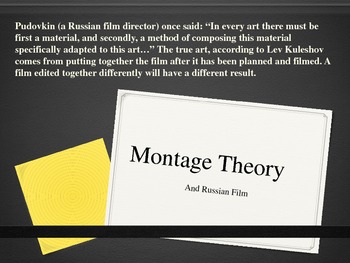


He inspired filmmakers such as Sergei Eisenstein ( Battleship Potemkin), who was formerly a student of Kulshov, and Dsiga Werov ( The Man With a Movie Camera). Kulshov’s theory asked questions as to how editing and composition influences a viewer’s interpretation of a sequence. In this way, Kulshov was applying tools more commonly associated with literature and language, forming sequences as you would a sentence rather than composing a scene as if it were a live theatrical production. To prove his point, the filmmaker cut together various images, each of which changed the audience's reading: The same facial expression, applied to different situations, will be interpreted entirely differently by the audience depending on its collective context.

The audience are able to view two separate images and subconsciously give them a collective context. This would become known as the Kuleshov Effect. Director Lev Kulshov first conceptualised montage theory on the basis that one frame may not be enough to convey an idea or an emotion. Just like French Impressionist cinema, Soviet Montage came from the concept that film theory doesn't necessary have to align with theatrical frameworks, as the filmmaking process provides an entirely new set of tools.


 0 kommentar(er)
0 kommentar(er)
